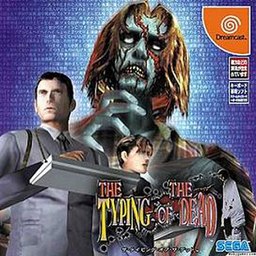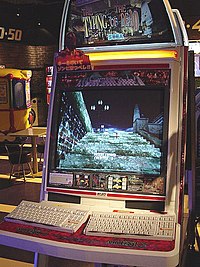
The Dreamcast is the final home video game console manufactured by Sega. It was released on November 27, 1998, in Japan; September 9, 1999, in North America; and October 14, 1999, in Europe. It was the first sixth-generation video game console, preceding Sony's PlayStation 2, Nintendo's GameCube, and Microsoft's Xbox. The Dreamcast's 2001 discontinuation ended Sega's 18 years in the console market.
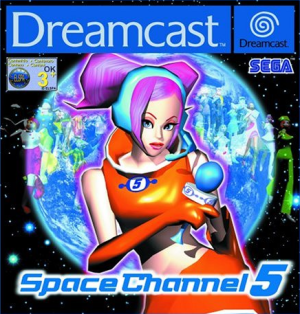
Space Channel 5 is a music video game developed by Sega AM9 and published by Sega. Originally released for the Dreamcast, it was later ported to the PlayStation 2. A version for the Game Boy Advance (GBA) was published in 2003 as a Western exclusive. Following space-faring reporter Ulala as she investigates an alien invasion, players engage in rhythm-based combat where Ulala mimics the actions of rivals in time to musical tracks.
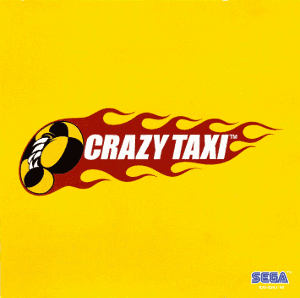
Crazy Taxi is a racing video game developed and published by Sega. It is the first game in the Crazy Taxi series. The game was first released in arcades in 1999 and then was ported to the Dreamcast in 2000. Gameplay is based on picking up taxi customers and driving to their destination as quickly as possible. Reception to Crazy Taxi has been mostly positive. It was ported to other platforms numerous times, including the PlayStation 2 and GameCube by Acclaim in 2001, and then Windows in 2002.

Soulcalibur is a weapon-based 3D fighting game developed by Project Soul and produced by Namco. It is the second game in the Soulcalibur series, preceded by Soul Edge in December 1995. Originally released in arcades on July 30, 1998, it ran on the Namco System 12 hardware. It was ported to the Dreamcast in 1999 with new features and improved graphics. The North American version was released in September 1999 as a launch game for the Dreamcast and was part of the successful launch of the new console. It became available as a downloadable title on the Xbox 360's Xbox Live Marketplace in July 2008 and it is forward compatible with the Xbox One along with the sequel, Soulcalibur II.
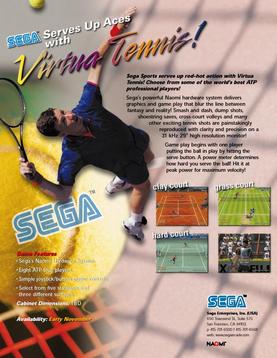
Virtua Tennis, known in Japan as Power Smash, is a 1999 tennis arcade game created by Sega. The player competes through tennis tournaments in an arcade mode. It was ported to the Dreamcast in 2000, and to Windows in 2002. A Game Boy Advance version was also released in 2002, followed by an N-Gage version in 2003. For the home console market, the game was expanded with the introduction of the campaign mode.

Yu Suzuki is a Japanese game designer, producer, programmer, and engineer, who headed Sega's AM2 team for 18 years. Considered one of the first auteurs of video games, he has been responsible for a number of Sega's arcade hits, including three-dimensional sprite-scaling games that used "taikan" motion simulator arcade cabinets, such as Hang-On, Space Harrier, Out Run and After Burner, and pioneering polygonal 3D games such as Virtua Racing and Virtua Fighter, which are some of the games besides others from rival companies during that era credited with popularizing 3D graphics in video games; as well as the critically acclaimed Shenmue series. As a hardware engineer, he led the development of various arcade system boards, including the Sega Space Harrier, Model 1, Model 2 and Model 3, and was involved in the technical development of the Dreamcast console and its corresponding NAOMI arcade hardware.
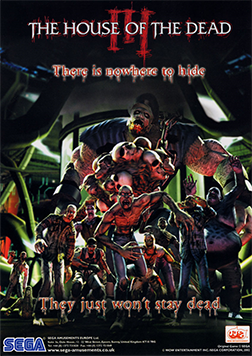
The House of the Dead III is a 2002 horror-themed light gun arcade game and the third installment of the House of the Dead series of video games, developed by Wow Entertainment and Sega. It was ported to the Xbox in 2003, Microsoft Windows in 2005, the Wii in 2008 in a compilation with The House of the Dead 2, and PlayStation 3 in 2012 with PlayStation Move support. The game was remade with typing controls as The Typing of the Dead 2 in 2008. The game continues the story of the previous games and introduces new gameplay concepts. The game's secondary protagonist is Lisa Rogan, daughter of Thomas Rogan and Sophie Richards.

Speed Busters is a video game developed by Ubisoft's Montreal studio for Microsoft Windows in 1998. It was released for the Dreamcast in 1999 as Speed Devils. It is a racing game in which the courses feature hazards such as dinosaurs rolling boulders, and UFOs in exotic locales including Louisiana, Louisiana Tornado, New York City, New York City Winter, Mexico, Nevada, Aspen Summer, Aspen Winter, Canada, Canada Light Winter, Canada Heavy Winter, Montreal Industrial, Hollywood, and Hollywood Disaster. The console version's career mode allowed the player to rise themselves through the ranks of a fictional racing league. Colourful rivals challenge the player to accomplish certain feats during races, making accompanying bets using prize money from competition. Money earned from gambling and performance is used to buy cars, upgrade them, and maintain them. The game also supports five players on one Dreamcast console.
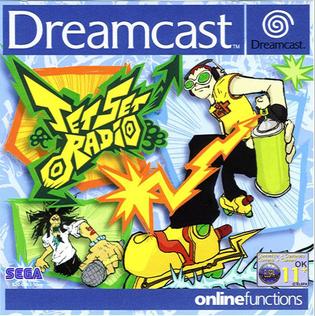
Jet Set Radio is a 2000 action game developed by Smilebit and published by Sega for the Dreamcast. The player controls a member of a youth gang, the GGs, as they use inline skates to traverse Tokyo, spraying graffiti, challenging rival gangs, and evading authorities.

Sega Rally 2 is an arcade racing game developed by Sega for the Model 3 arcade hardware. It is the sequel to 1994's Sega Rally Championship. The game was first released in arcades in February 1998, and was later ported to the Sega Dreamcast, becoming one of the console's earliest titles when it was released in Japan on January 28, 1999. The Sega Dreamcast version was released in Europe as a launch title on October 14, 1999, and then in North America on November 27. A PC version was released in Japan and Europe that same year, with the North American release following suit in September 2000, where it was published by Mattel Interactive.

NFL 2K2 is a 2001 video game for Dreamcast by Sega and developed by Visual Concepts. It is the last game for the Sega Dreamcast in the series after being discontinued before Sega shifted to a third party publisher. Because of this shift, it was released later for PlayStation 2 and Xbox. It is also the first Xbox game published by Sega, and the last game in the NFL 2K series to feature Randy Moss as a cover athlete.
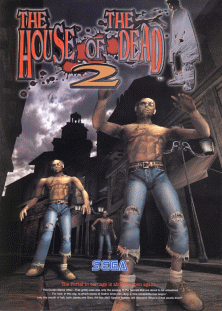
The House of the Dead 2 is a horror-themed light gun shooter arcade game and the second game in The House of the Dead series of video games. The direct sequel to The House of the Dead, it was developed by Sega for arcades on the Sega NAOMI board in November 1998, and received several home ports, starting with the Dreamcast in 1999, Microsoft Windows in 2001, Xbox in 2002 as a bonus in The House of the Dead III and on Wii as part of the compilation The House of the Dead 2 & 3 Return. It would also serve as the basis for several spinoff games in the franchise, most notably The Typing of the Dead.

The House of the Dead, also referred to as Curien Mansion, is a horror-themed light gun shooter video game franchise created by Sega in 1996. Originally released in arcades, it utilizes a light gun on the platform, but can be played with standard controllers on consoles and a mouse or keyboard on home computers. For the PlayStation Network releases of III and 4, they can also be played using the PlayStation Move controller.

Sega Bass Fishing, known in Japan as Get Bass, is an arcade fishing video game developed in 1997 by Sega for the Sega Model 3 hardware. The game has since been ported to the Dreamcast, Microsoft Windows, Xbox 360, PlayStation 3 and Wii.

Space Channel 5: Part 2 is a music video game developed by United Game Artists. A direct sequel to the 1999 game Space Channel 5, the game was published for Dreamcast and PlayStation 2 in Japan in February 2002 by Sega. The PS2 version released worldwide in 2003 by SCEE and Agetec. The game later received a high-definition port to Microsoft Windows, Xbox 360 and PlayStation 3 in 2011 from Sega.

Hundred Swords is a real-time strategy video game developed by Smilebit and published by Sega in Japan for the Dreamcast and on the PC in the US by Activision Value. The PC release was compatible with Windows 95, 98, and Me.

Sega Corporation is a Japanese multinational video game company and subsidiary of Sega Sammy Holdings headquartered in Shinagawa, Tokyo. It produces several multi-million-selling game franchises for arcades and consoles, including Sonic the Hedgehog, Angry Birds, Puyo Puyo, Super Monkey Ball, Total War, Virtua Fighter, and Yakuza. From 1983 until 2001, Sega also developed its own consoles.
